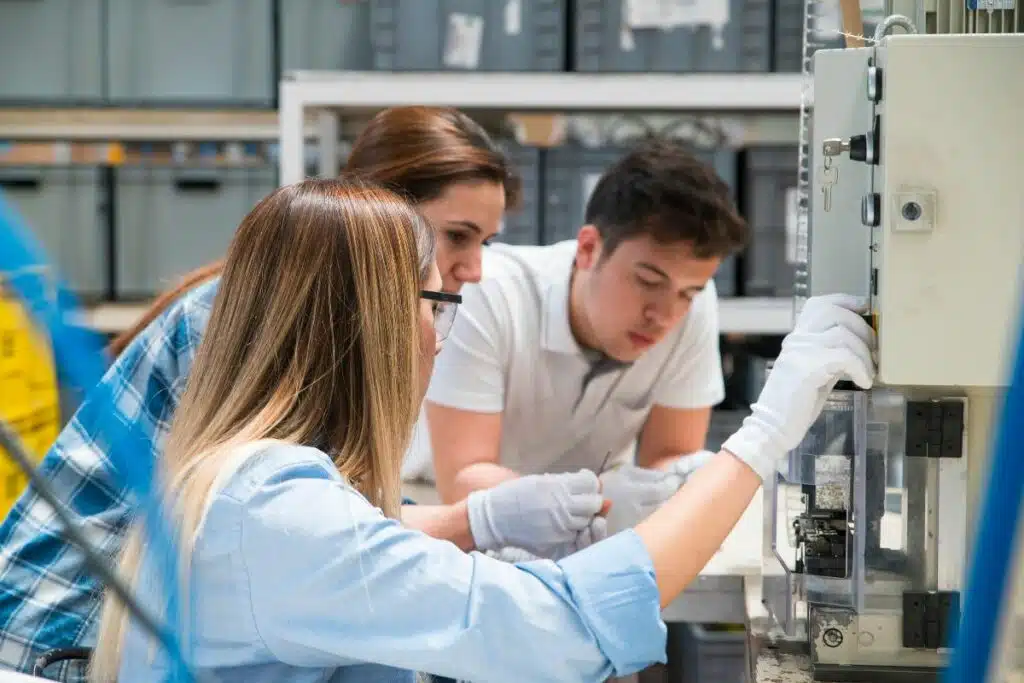Key Takeaways:
- PLM’s Role and Uses: Product Lifecycle Management is a critical process for managing a product’s journey from market introduction to withdrawal. It’s essential for developing strategies, making decisions about product portfolios, and determining pricing and marketing strategies.
- Stages of the Product Lifecycle: The lifecycle includes the Concept Stage, Design Stage, Production Stage, Sales Stage, Support Stage, and Retirement Stage. Each stage is integral to the product’s success, from initial brainstorming and design to sales, customer support, and eventual retirement.
- Measuring Product Lifecycles: Effective PLM can be measured through metrics like team efficiency, product quality, time-to-market efficiency, development costs, revenue from new products, product development cycle duration, product life, waste generation, and product reliability.
What is PLM (Product Lifecycle Management)?
Product Lifecycle Management (PLM) involves strategically managing a product’s journey from its creation to market withdrawal. It encompasses stages of growth, maturity, and decline. PLM is essential for strategy formulation, pricing, marketing, and determining the lifecycle of products, including expansion and discontinuation.
It’s a multifaceted process that leverages technology for effective product management, aiming to maximize business profits. Integrating PLM with robust ERP software enhances its efficacy, as it combines product development, supply chain, and CRM, thereby streamlining processes and connecting vital organizational information.


History of Product Lifecycle Management
The origins of Product Lifecycle Management (PLM) trace back to the early 1980s, evolving from the concept of Computer-Aided Design (CAD). It was developed to address the need for better tools to manage the complexity of the design and manufacturing processes. The initial focus was primarily on automating the drafting process. Over time, PLM expanded to encompass a broader range of functionalities, integrating product data management (PDM) to coordinate and control all the information related to a product.
As technology advanced, PLM systems began to incorporate supply chain management and customer feedback, transforming into a comprehensive solution for managing all stages of a product’s lifecycle. This historical progression has laid the foundation for the modern, integrated PLM systems we see in 2024, which are more collaborative, data-driven, and efficient.
Why Do Companies Need PLM?
Companies need Product Lifecycle Management (PLM) because it centralizes and streamlines all aspects of product development and management. This system enhances collaboration among various departments, improves efficiency, and reduces time-to-market for products. PLM aids in managing complex processes from design to disposal, ensuring compliance with industry standards and reducing errors and costs. By integrating different stages of product development, PLM provides a comprehensive framework for decision-making, enhances innovation, and adapts to changing market demands, making it an essential tool for businesses in various industries.
What Is the Product Lifecycle?
The Product Lifecycle refers to the stages a product goes through from conception to withdrawal from the market. It includes five key phases:
- Development: The initial stage where the product is conceptualized, designed, and developed.
- Introduction: The product is launched and introduced into the market; marketing strategies are implemented.
- Growth: Sales begin to increase significantly, and the product gains market share.
- Maturity: The product reaches peak sales; the market may become saturated.
- Decline: Demand for the product decreases, leading to reduced sales and possibly its eventual withdrawal from the market.
Product Lifecycle Examples
Let’s consider a fictional brand “GlowBrite” and its journey through the Product Lifecycle:
- Development: GlowBrite creates a new organic facial cream, focusing on sustainable and natural ingredients. This phase involves researching, formulating, and testing the product.
- Introduction: The facial cream is launched with a targeted marketing campaign, focusing on eco-conscious consumers. Initial sales are moderate as the brand builds awareness.
- Growth: Positive reviews and word-of-mouth recommendations lead to increased sales. GlowBrite expands its distribution to more stores and online platforms.
- Maturity: The facial cream reaches peak popularity. GlowBrite faces stiff competition but maintains a strong market position through customer loyalty programs and periodic updates to the formula.
- Decline: Newer, more innovative products enter the market, leading to a gradual decline in sales for GlowBrite’s facial cream. The company begins to consider phasing out the product or reinventing it.
How does Product Lifecycle Management work?
Product Lifecycle Management (PLM) functions as a strategic and systematic approach to managing the lifecycle of a product from its initial concept to its eventual retirement. It integrates people, processes, business systems, and information to streamline the product development process. PLM begins with the inception of a product idea and continues through design and manufacturing, to service and disposal.


It encompasses various stages, including product design, engineering, manufacturing process planning, and feedback incorporation. Through PLM, businesses can manage product-related data, track changes, improve collaboration across departments, and ensure that product development aligns with the company’s business objectives.
Benefits of Product Lifecycle Management
Adopting PLM in 2024 offers numerous benefits, including:
- Enhanced Productivity and Efficiency: Streamlined processes reduce time-to-market and operational costs.
- Improved Quality and Compliance: Consistent quality control and compliance with global standards.
- Innovation and Competitive Edge: Fosters innovation by efficiently managing resources and insights.
How do I measure the Product Lifecycles?
Product Lifecycle Management (PLM) significantly enhances team collaboration across various departments, aligning them towards shared objectives and key performance metrics. Effective PLM can be measured through several critical metrics:
- Enhanced Team Efficiency: A well-implemented PLM should lead to a noticeable boost in overall team efficiency due to improved collaboration.
- Output Quality: With a robust PLM system, the quality of products is expected to increase, evidenced by a higher rate of defect-free units produced initially.
- Market Launch Timing: Effective PLM streamlines various processes, aiding in adhering to planned product launch schedules.
- Management of Development Costs: PLM integrated with ERP can streamline processes, leading to more efficient teams and controlled development costs.
- Revenue Generation from New Launches: Quality products developed quickly through PLM tend to increase revenue.
- Development Cycle Duration: This involves tracking the entire time span from the initial design phase to the final marketing stage of the product.
- Usage Duration of Products: Assessing how long customers use the product provides insights for future product development.
- Generation of Waste per Product: This metric examines the environmental impact by measuring waste produced during product development.
- Durability and Customer Service Metrics: Assess the sturdiness of products and track the frequency of warranty claims to measure product reliability.
Product Lifecycle Management Stages
Product Lifecycle Management (PLM) encompasses distinct stages that every product generally goes through.
- Concept Stage: This initial stage involves brainstorming ideas, conducting market research, identifying customer needs, and assessing the product’s feasibility. It’s typically led by research and development teams.
- Design Stage: Here, the product is designed, developed, and tested. This includes creating prototypes, refining the design, and ensuring compliance with all regulations.
- Production Stage: In this stage, the product is manufactured. It involves sourcing materials, assembling components, and final product testing.
- Sales Stage: This stage focuses on marketing and selling the product, employing strategies like advertising and pricing.
- Support Stage: Post-sale, this stage includes providing customer service, warranties, and repairs.
- Retirement Stage: The final stage, where a product is retired, involves disposal, recycling, or repurposing, often leading to new product versions.
Each stage is crucial for the product’s success and longevity in the market.
The Future of PLM
Looking ahead, PLM is expected to become more interconnected with emerging technologies like augmented reality (AR) and blockchain, further enhancing its capabilities. The emphasis will likely shift towards sustainability and eco-friendly product development, resonating with global environmental concerns.